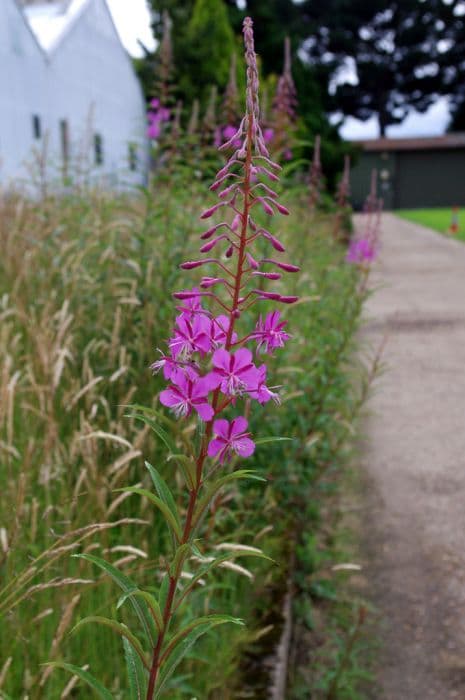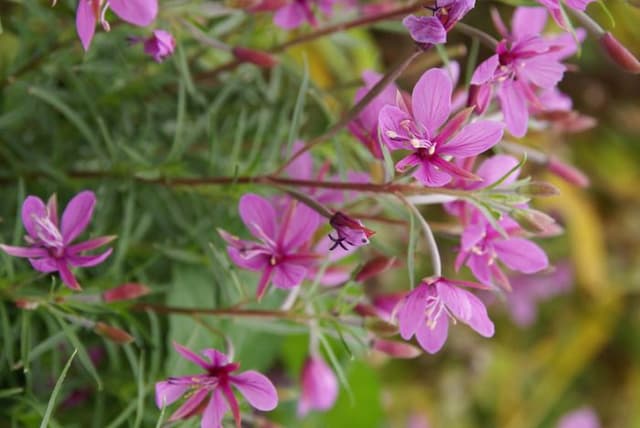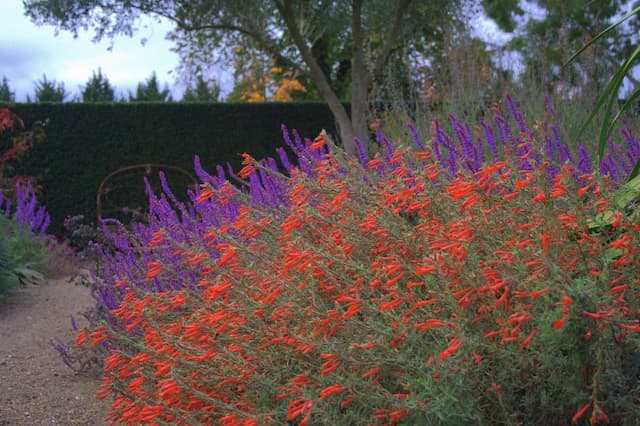Pink evening primrose Oenothera speciosa

ABOUT
The plant with the common name Pink Evening Primrose captures attention with its showy and delicate flowers. These blossoms are typically a soft pink hue, sometimes with a gradient that fades to white towards the center. Occasionally, pure white blooms may also be found. Each flower features four broad petals that create a distinctive cup-like shape. At the center, a vibrant yellow stamen stands out, contrasting beautifully with the pink petals. The foliage of Pink Evening Primrose is equally appealing, composed of narrow, lance-shaped leaves that provide a rich green backdrop for the flowers. These leaves are arranged in a rosette pattern and have a slightly toothed margin, giving them a somewhat ruffled appearance. Pink Evening Primrose often spreads across the ground, forming lovely patches that can transform an area into a carpet of pink during its blooming period. Overall, the display of flowers coupled with the verdant leaves makes this plant a charming addition to any garden or landscape where a touch of soft color is desired.
About this plant
 Names
NamesSynonyms
Pink Evening Primrose, Pink Ladies, Showy Evening Primrose, Mexican Primrose, Amapola.
Common names
Hartmannia speciosa, Xylopleurum speciosum.
 Toxicity
ToxicityTo humans
Oenothera speciosa, commonly known as Pinkladies or Pink Evening Primrose, is not considered toxic to humans. There are no significant reports of poisoning or toxicity from ingesting or handling this plant. Therefore, no symptoms of poisoning or toxicity are generally expected upon ingestion by humans.
To pets
Pinkladies or Pink Evening Primrose is not known to be toxic to pets. There are no common reports of toxicity in domestic animals, such as dogs and cats, from ingesting this plant. As such, no particular symptoms of poisoning are generally associated with it. However, individual animals may have unique sensitivities, so it is always wise to monitor pets and prevent them from eating plants not meant for consumption.
 Characteristics
CharacteristicsLife cycle
Perennials
Foliage type
Deciduous
Color of leaves
Green
Flower color
Pink
Height
1-2 feet (30-60 cm)
Spread
1-2 feet (30-60 cm)
Plant type
Herb
Hardiness zones
5
Native area
North America
Benefits
 General Benefits
General Benefits- Attracts Pollinators: Oenothera speciosa, commonly known as Pinkladies or Pink evening primrose, is known to attract bees, butterflies and hummingbirds, contributing to pollination in the garden.
- Drought Tolerant: Once established, Pinkladies are highly drought-resistant, making them suitable for xeriscaping and water-wise gardens.
- Low Maintenance: These plants require minimal care, thriving in poor soil and needing little watering or fertilization after they are established.
- Fast Growth: Pinkladies grow quickly and can cover bare spots in gardens, providing a lush green appearance throughout the growing season.
- Erosion Control: The spreading nature and the fibrous root system of Pinkladies help to stabilize soil and prevent erosion.
- Extended Blooming Period: Pinkladies bloom for a long period, from spring to fall, offering a long-lasting display of flowers.
- Wildlife Habitat: The dense foliage provides shelter for small wildlife, including beneficial insects and small birds.
- Groundcover: Can be used as an effective groundcover due to its spreading habit, covering large areas and suppressing weeds.
- Ornamental Value: With their pretty pink flowers and delicate foliage, Pinkladies add aesthetic value to gardens and landscapes.
- Night Blooming: Flowers typically open in the evening, adding interest to the garden during dusk and nighttime hours.
 Medical Properties
Medical Properties- Anti-inflammatory: The plant has been traditionally used for its potential anti-inflammatory properties.
- Wound healing: Oenothera speciosa has been used in folk medicine to aid in the healing of minor wounds.
- Skin conditions: It may be used in traditional remedies for various skin conditions, due to its soothing effects.
- Gastrointestinal aid: There is some historical use of the plant for digestive issues, although scientific evidence is limited.
 Air-purifying Qualities
Air-purifying QualitiesThis plant is not specifically known for air purifying qualities.
 Other Uses
Other Uses- Oenothera speciosa, commonly known as Pink Evening Primrose, is often used in erosion control due to its deep rooting system that helps hold the soil together, making it useful for stabilizing banks and slopes.
- In landscapes, Pink Evening Primrose can serve as a ground cover because of its spreading habit and ability to form a dense mat, which suppresses weed growth.
- The plant is sometimes cultivated as an ornamental in gardens for its attractive flowers and can be used in mixed borders or mass plantings for visual appeal.
- Pink Evening Primrose is suitable for xeriscaping, which is a method of landscaping that reduces or eliminates the need for supplemental water from irrigation, making it valuable in drought-prone regions.
- The flowers of Oenothera speciosa can be used to add a decorative touch to salads and other dishes, as they are edible and have a sweet taste.
- It has potential use in phytoremediation, as certain species in the Oenothera genus have been shown to absorb heavy metals from contaminated soils, although specific research on Oenothera speciosa may be limited.
- This plant serves as a valuable nectar and pollen source for pollinators, including bees, butterflies, and moths, thereby contributing to the health and maintenance of local ecosystems.
- The stems and leaves can be used to make natural dyes, providing a variety of colors for fabrics and other materials depending on the mordant used.
- Pink Evening Primrose can be planted near fruit and vegetable gardens to attract pollinators which are essential for the production of fruits and seeds, helping to increase crop yields.
- In artistic applications, the ephemeral beauty of Pink Evening Primrose blooms, which open in the evening and wither the following day, can offer inspiration for photographers and painters keen to capture the fleeting nature of flowers.
Interesting Facts
 Feng Shui
Feng ShuiThe Pink Evening Primrose is not used in Feng Shui practice.
 Zodiac Sign Compitability
Zodiac Sign CompitabilityThe Pink Evening Primrose is not used in astrology practice.
 Plant Symbolism
Plant Symbolism- Adaptability: Oenothera speciosa, commonly known as the Pinkladies or Pink evening primrose, quickly adapts to various environments, symbolizing flexibility and resilience.
- Peace: The soothing pink hues of the Pinkladies may represent tranquility and calmness, offering a sense of peace.
- Youthful Playfulness: The delicate and cheerful appearance of the Pink evening primrose flowers suggests a sense of innocence and the joy of youth.
- Seeking Opportunities: As the flowers of Pinkladies often open in the evening or on cloudy days, they symbolize making the most of opportunities whenever they arise.
 Water
WaterThe Pink Evening Primrose should be watered deeply but infrequently, allowing the soil to dry out between waterings. Typically, watering once a week with about 1 inch of water should suffice, but this may vary depending on climate conditions. During the hot, dry summer months, you may need to increase the frequency to every few days, especially if the plant shows signs of wilting or stress. For potted specimens, ensure that excess water can drain out to prevent root rot. It's important to avoid overhead watering to keep the foliage dry and reduce the risk of disease.
 Light
LightPink Evening Primrose thrives in full sun, where it can receive at least 6 hours of direct sunlight daily. The ideal spot for Pink Evening Primrose is an open area with clear exposure to the sky, away from the shade of larger plants or structures. This plant can tolerate partial shade but will produce fewer flowers and may become leggy if not given enough light.
 Temperature
TemperaturePink Evening Primrose prefers moderate temperatures and grows best in conditions between 60 and 75 degrees Fahrenheit. It can survive minimum temperatures down to about 20 degrees Fahrenheit but should be protected from prolonged freezing conditions. During heat waves, with temperatures soaring above 90 degrees Fahrenheit, make sure the plant receives adequate water to prevent stress.
 Pruning
PruningPruning Pink Evening Primrose is necessary to maintain its shape, encourage new growth, and remove spent flowers to prolong blooming. Prune lightly throughout the blooming season to deadhead and remove any damaged or unhealthy stems. The best time for a more thorough pruning is in late fall or early spring, though regular deadheading can occur anytime during the flowering period.
 Cleaning
CleaningAs needed
 Soil
SoilThe best soil mix for the Pink Evening Primrose (common name of Oenothera speciosa) is well-draining soil rich in organic matter. It prefers a neutral to slightly acidic pH, ideally between 5.5 to 7.0. A blend of garden soil with added compost and perlite or sand will ensure proper drainage and fertility.
 Repotting
RepottingPink Evening Primrose rarely needs repotting as it can thrive in the same spot for several years. It's a perennial that's often grown as an annual; however, if it's grown in containers, consider repotting every 2 to 3 years to refresh the soil.
 Humidity & Misting
Humidity & MistingPink Evening Primrose is not particularly sensitive to humidity levels; it grows well in average atmospheric humidity. This plant is quite adaptable to different humidity conditions and does not require any specific humidity adjustments.
 Suitable locations
Suitable locationsIndoor
Place Pink Evening Primrose in a sunny spot with direct light.
Outdoor
Plant in full sun, well-drained soil, divide every 2-3 years.
Hardiness zone
4-9 USDA
 Life cycle
Life cycleOenothera speciosa, commonly known as the Pink Evening Primrose, begins its life cycle as a seed that germinates in spring when temperatures become favorable. It grows into a rosette of leaves at ground level, where it may stay dormant for a season or start producing flowering stems the same year. Flowering typically occurs from late spring to mid-summer, with large, fragrant pink blooms that open in the evening and close by the next noon. After pollination, often by night-flying insects such as moths, the plant sets seed in the form of a capsule containing many tiny seeds. The seeds are dispersed by wind or animals, and once they land in a suitable location, they can remain dormant in the soil for several years before germinating when conditions are right. Oenothera speciosa is a perennial plant, and after the flowering season, it may die back to the ground in colder climates but regrow from the same root system the following year.
 Propogation
PropogationPropogation time
Spring to early summer
The most popular method of propagation for Oenothera speciosa, commonly known as Pink Evening Primrose or Showy Evening Primrose, is by seed. Seeds can be directly sown in the ground in fall or early spring. In regions with mild winters, sowing in the fall allows the seeds to undergo a natural stratification process, which is a period of cold treatment that many seeds require to break dormancy and germinate more effectively. When sowing seeds in the spring, it's beneficial to first stratify them artificially by placing them in a moist medium inside a plastic bag and refrigerating them for about 4-6 weeks. Afterward, seeds are scattered on the surface of well-drained soil and lightly pressed in or covered with a thin layer of soil, typically no more than 1/8 inch (approximately 3 millimeters) deep, as they require light to germinate. Germination will usually occur in 2-3 weeks if they are kept at around 70°F (21°C). Once the seeds germinate and the seedlings have developed true leaves, they can be thinned out or transplanted to their desired locations in the garden.









